1985 Monaco Grand Prix race report
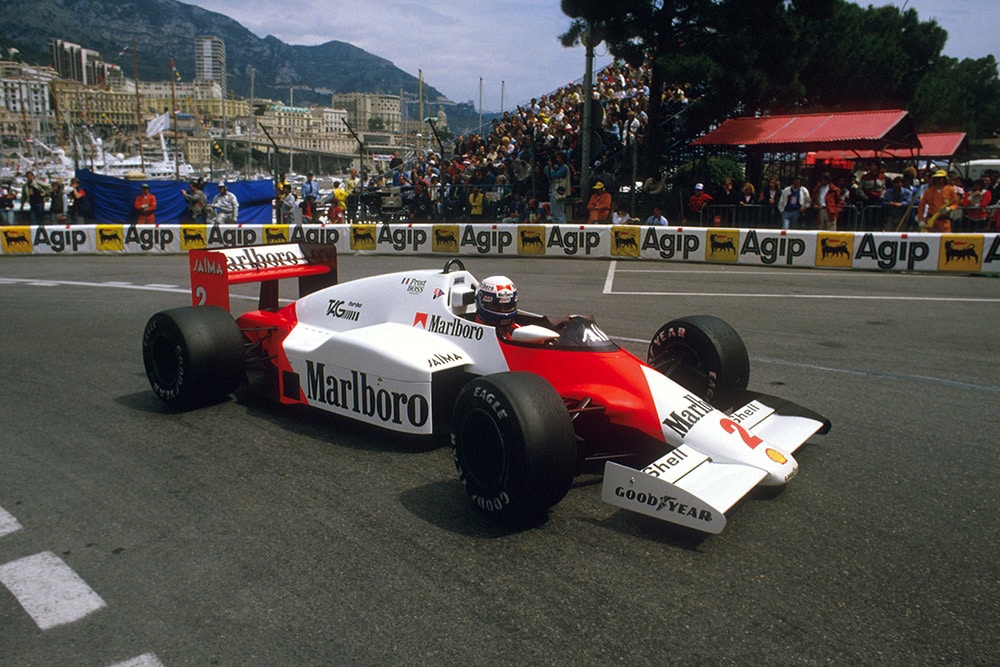
McLaren's Alain Prost took a second win of the season
Motorsport Images
THE way that FISA and FOCA operate to run the world of Formula One is beyond the comprehension of normal motor racing enthusiasts like you and me, so there is no point in worrying about it. Merely accept the result and take the rough with the smooth. Overall it cannot be too bad, otherwise Formula One would be dying in popularity and the starting grids would be full of a bunch of mediocre runners. The truth is the complete opposite; enthusiasm for Formula One is as high as ever and we have not had such a competitive field for a longtime.
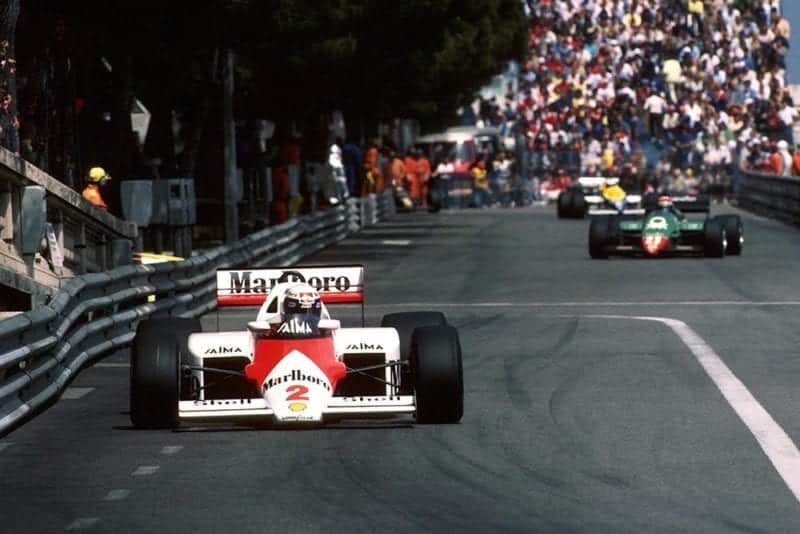
Race winner Alain Prost leads the pack in his McLaren MP4/2B.
© Motorsport Images
All this brings us to two important FISAIFOCA results, both enjoyable, both satisfactory, but both inexplicable. I refer to the Monaco GP taking place on May 19th, when all the winter noises from Paris said there would not be a Monaco GP, and the appearance of Teo Fabi in a Toleman-Hart Car running on Pirelli ryres, when all the winter noises from Witney said the Toleman team had no tyres and would not be racing this year. Don’t ask why, just accept the facts, though if you like worrying about things you can ponder on the facts that the Spirit team’s single car entry disappeared, the Benetton Italian clothing people put some money somewhere, Teo Fabi is Italian, and Toleman’s number one driver Stefan Johansson was released to join the Ferrari team because there was a vacancy brought about by Rene Arnoux leaving the Ferrari team.
If Arnoux had not left Ferrari, Johansson would not have joined them and would have still been number one at Toleman, which would have meant that Fabi could not have driven the single Toleman entry, and if Fabi couldn’t drive there would have been no Benetton money, and with no Benetton money the Spirit team would not have gone away, and with Spirit still in the entry list there would have been no surplus Pirelli tyres.
As I said, the workings of FISA and FOCA are not for us to question, but how fortunate that Arnoux chose to leave Ferrari and take a rest from Formula One. As regards the Monaco race itself nobody really believed. it was cancelled.. It was a bit like not having Christmas Cake on December 25th. So everyone was in place for the annual thrash round the iron-clad streets of Monte Carlo, and those who know about Mediterranean weather predicted rain and grey skies. Fortunately they were-wrong. As a precaution the more affluent teams brought along additional spare cars, as it is all too easy to severely damage a car at Monaco as run-off areas and escape routes are few and far between.
So Brabham, Lotus, Renault and Ferrari had four cars apiece in or around Monte Carlo. Brabham had theirs at nearby Paul Ricard for some last-minute Pirelli tyre testing on the Friday. In order to extract the maximum amount of money from the Formula One entourage, practice and qualifying is arranged for Thursday and Saturday, with Friday given over to national events.
Qualifying
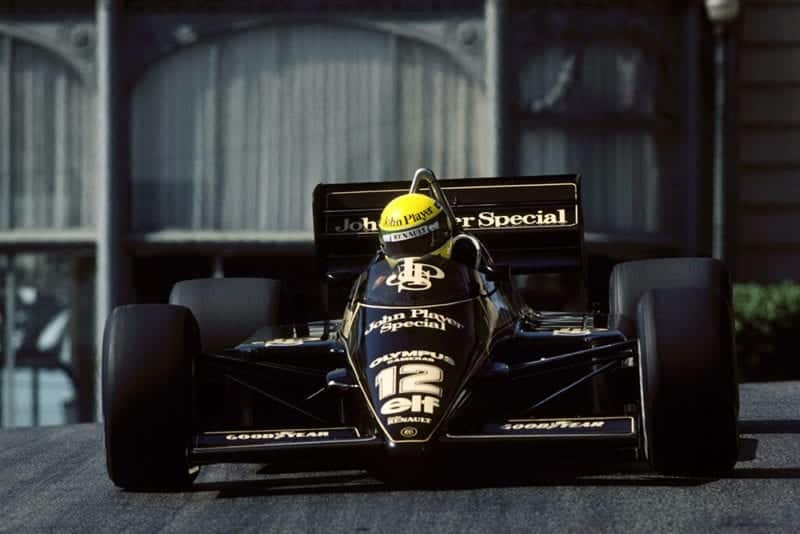
Ayrton Senna claimed a sensational pole in his Lotus
Motorsport Images
Thursday was fine and dry and and soon everyone was thrashing round preparing for the afternoon timed session, though Mansell lost time having his Williams repaired after he had hit a barrier, and Winkelhock crumpled both ends of his RAM-Hart and it was not instantly repairable. Fuel consumption was not a vital issue but brakes and tyres were, so these were the things most people were concentrating on. For the drivers it was smoothness and consistency that was going to payoff, and though he was not the fastest , Lauda was outstanding to watch on the twisty bit from Casino Square down to the sea front. However, it was the hour in the afternoon that really mattered, for then lap times counted for the starting grid’, and ‘in the confines of the Monagasque streets it was all-important to be at the head of the pack, to get a clear run on race day; in other words pole position was important, plus the fact, as Senna said to the local pressmen, it avoids you~ getting involved in any start-line accidents!
After dominating qualifying in Portugal and again at Imola, it was no surprise to see Senna’s name at the top of the list. The ignominiously into a run-off area! During this little comedy Senna put in a lap in 1 min 20.486 sec, so once again he was first and second! Mansell’s heroic effort was 1 min 20.536 sec.
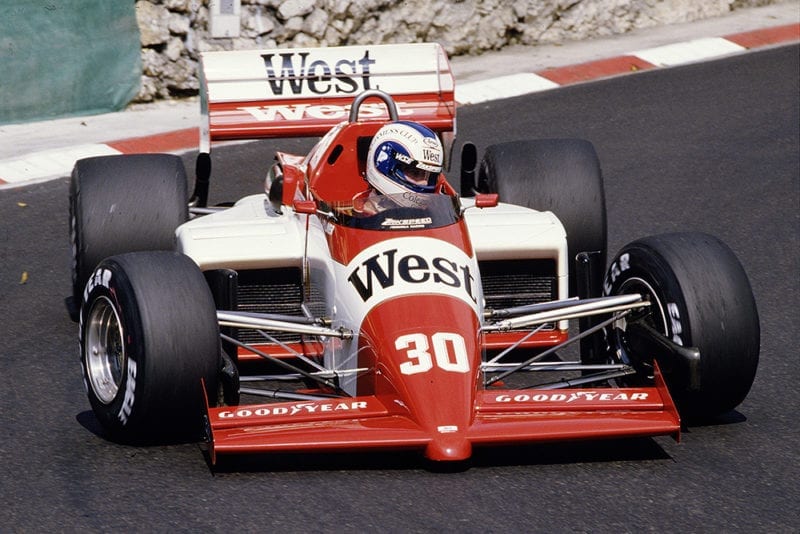
Jonathan Palmer qualified 19th for Zakspeed
Motorsport Images
Down at the bottom end of the field Brundle had taken every opportunity and got in a fine lap that gave him 18th position, while Palmer battled the Zakspeed round into 19th place. Last place on the grid went to Fabi in the Toleman-Hart, which was a fine effort for a first time out this year for both car and driver. Of the non-qualifiers the RAM team were in so much trouble with their drivers crashing that it was no surprise to see them left out, while the Minardi team had a bad time when Martini crashed pretty badly) injuring a knee and there was not time to build up a second car, even though they had the bare bones of a car with them.
After the tempo and excitement of that hour on Saturday afternoon I was ready to go home; Sunday’s race could only be an anticlimax.
Race
Sunday morning was grey and cool, and there was a suspicion of rain in the air, but the clouds were high and though things looked dull, they looked stable. On the engine front Renault were holding the scene, for not only did they have a 1985 longer-stroke engine in Tambay’s car, but Lotus had them in both their cars and Ligier had one in their car for de Cesaris. After the 30 min warm-up in the morning, de Angelis decided he wanted a 1984 engine back in his car and so did Tambay and de Cesaris, and with the modem design facility that allows an instant engine change these requests presented no problem. Senna was content to stay with his 1985 engine as he considered the wider torque spread was more suitable for the circuit. During the warm-up running he had inadvertently over-revved, but it didn’t seem to have done any harm.
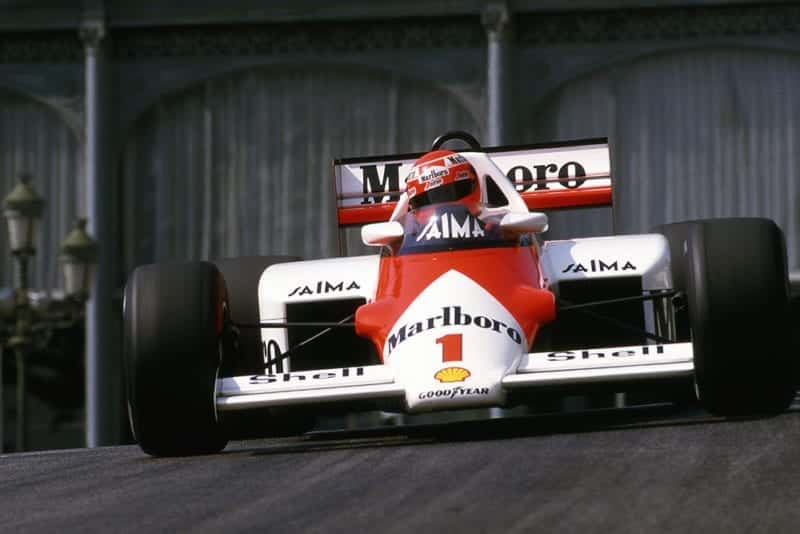
Niki Lauda found himself down in 14th after qualifying
Motorsport Images
When the engine change had been completed on the car of de Angelis, it developed a misfire and as time was running out he transferred to the T-car with 1984 engine, which had been set up for Senna. Lotus troubles were only just beginning. ‘
The start was due at 3.30 pm after various parades and demonstrations arid the Royal party had descended from the Palace down to the Royal Box by the starting grid. During the minutes before the s~t Team Lotus warm the tyres on their cars by means of covers like electric blankets and all was proceeding normally when those on ‘ the front of Senna’s car s’tarted to smoke and make an awful smell. Before every- ‘ thing caught fire they were switched off but the tyres were blistered, so there was no alternative but to fit a new pair of wheels and tyres on the front, which meant.he went out to the start with hot tyres on the rear and cold ones on the front! He led them round on the parade lap, for the third race in a row, and back to the start. From the green light he shot off into the lead, followed by Mansell and Alboreto. At the back of the grid there was a bit of a shunt, caused inadvertently by Gerhard Berger when the BMW engine in his Arrows A8 hesitated.
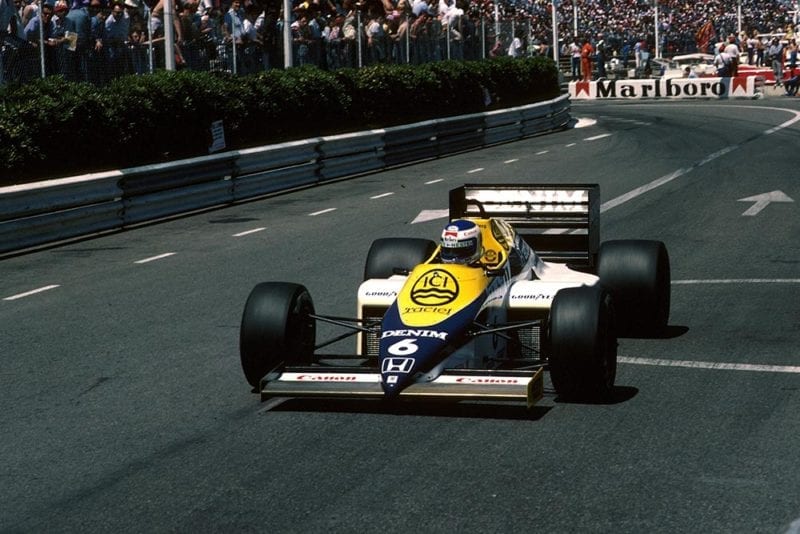
It was 7th on the grid for Williams’ Keke Rosberg
Motorsport Images
Johansson’s Ferrari and Tambay’s Renault were involved and while the Arrows and the Renault subsided into retirement before the first corner, the Ferrari limped round to the pits. A shock-absorber operating rod was bent and one more lap was enough to convince the unhappy Swede that the car was undriveable at racing speeds.
Alboreto sliced through into second place and closed right up on the leading Lotus in the first five laps, but that was while the cold front tyres were getting up to their working temperature. After that Senna just pulled away effortlessly. By ten laps it seemed that it was all over as far as contention for the lead was concerned. Senna had it all sewn up on the winding, twisting Monte Carlo circuit, just as he had in the rain in Portugal and in the dry on the fast circuit at Imola, but two laps later fate struck its blow. The Renault engine broke internally, either due to a valve and piston coming into contact, or a valve breaking, or a piston breaking, doubtless a legacy of the over-revving in the morning. Whatever the cause the result was mechanical mayhem and the end of Senna’s race; Alboreto swept by into the lead to the applause of the thousands of Ferrari fans around the circuit.

The cars make their way round the hairpin
Motorsport Images
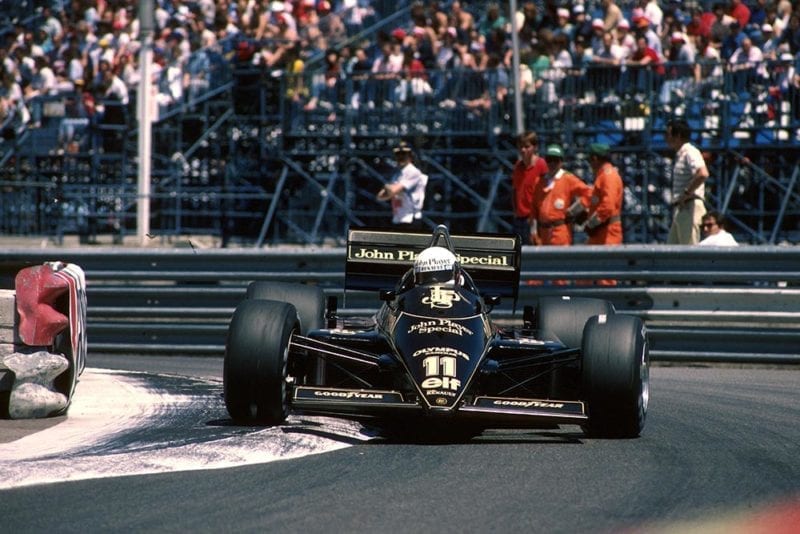
Elio De Angelis at the wheel of his Lotus 97T.
© Motorsport Images
Behind the leaders there were some interesting goings on, some to come to nought, others to affect the race overall. Mansell and Rosberg were in trouble with the brakes on their Williams-Hondas, these being of carbon-fibre and suffering temperature problems so both drivers had settled down to cruising round with the aim of finishing rather than trying to win. Mansell had de Cesaris, Warwick and Lauda pressing him for fifth place, while Rosberg’s fourth place disappeared later on when he had to stop for new tyres. Behind this lot Patrese was leading Piquet, Laffite and Fabi and clearly holding them up, the Alfa Romeo not going anything like as well as it did on the first day of qualifying.
On lap 17 Piquet made his run to overtake Patrese as they passed the pits heading for the Ste Devote chicane and the Alfa Romeo driver caused Piquet to hit the guard rails on the right and then both cars were spinning down the road in a pretty lurid accident. Laffite spun his Ligier in avoiding them and yellow flags waved in all directions. There was oil on the road and when Alboreto arrived next time round the Ferrari skated up the escape road, but the driver kept the engine running and reversed out to carry on racing, though not before Prost had gone by into the lead. Lauda also went off on the oil, but he stalled his Porsche engine and that was that.
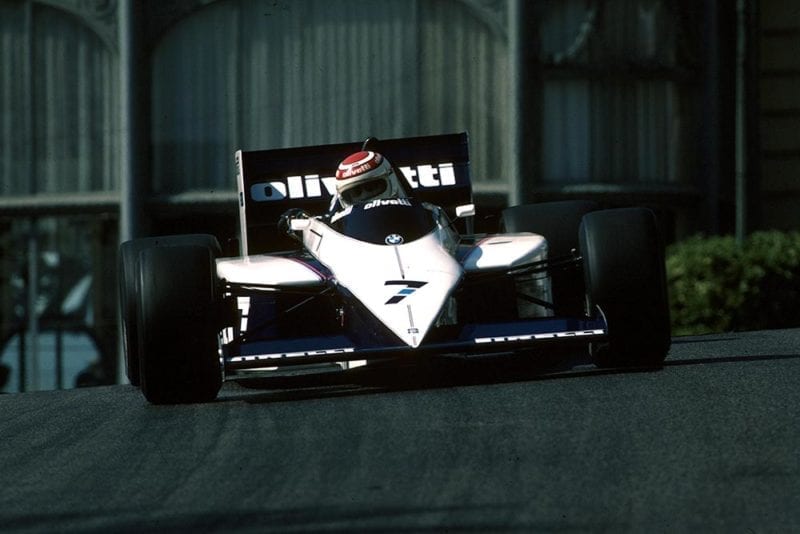
Nelson Piquet did not finish in his Brabham BT54.
© Motorsport Images
Prost had been sitting comfortably in third place in the opening stages, then becoming second when Senna retired, and was now leading thanks to Alboreto’s slight error. Many people blamed the marshals for not displaying oil flags, but the fact is that de Angelis, Rosberg, Mansell, Warwick, Brundle and Boutsen did not spin off on the same oil. Undeterred, Alboreto set about catching Prost and this he did by lap 21 and on lap 23 he outbraked the Frenchman and got back into the lead, driving beautifully.
Prost could not retaliate as his McLaren Porsche was proving to be a a bit of a handful; unbeknown until after the race one of the turbocharger boost control valves was sticking and the Porsche engine was giving a very unbalanced power output, making it very tricky to handle. As half distance approached Alboreto looked to be in complete control of the race, his smooth driving belying his speed, Prost was a firm second, de Angelis a distant third, de Cesaris a praiseworthy fourth followed by Warwick, Laffite and the two Williams drivers. Boutsen, Palmer and Brundle were a long way back. Suddenly the leading Ferrari headed for the pits with the left rear tyre flat and once more Prost was back in the lead. The Ferrari mechanics changed all four wheels and Alboreto was back in the race, but now down in fourth place; undeterred he began battling away again to overcome his handicap.
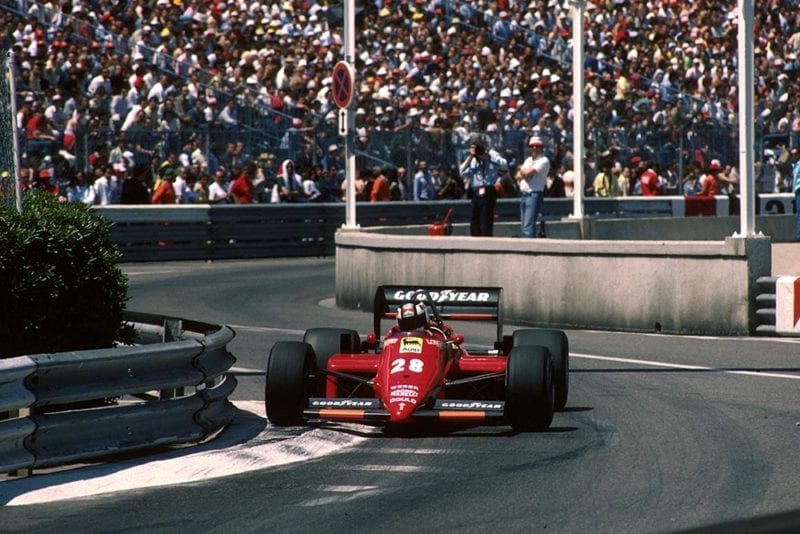
Ferrari’s Johansson was eliminated in an accident on lap 1
Motorsport Images
By lap 39 he was past de Cesaris and began the long job of catching de Angelis. The Lotus driver was doing his usual steady and consistent performance, now in second place, but in reality in an earned third place. The race was at its halfway point, the total distance being 78 laps, and one could have been forgiven for assuming that Alboreto would settle for a secure third place, but the quiet Italian had other ideas. Steadily and surely the Ferrari closed on the Lotus-Renault and by 60 laps Alboreto had the black and gold Lotus in his sights and de Angelis was trying all he could, but he had used up his brakes.
On lap 63 Alboreto was past and into second place and for a brief moment de Angelis tried to hang on to the tail of the red car, but it was all over. Alboreto continued to close on Prost but time was not on his side, and despite the erratic control of his engine Prost was completely unruffled and brought the McLaren home to a well-earned victory, though Alboreto must surely merit the moral victory.
Anyone who witnessed Ayrton Senna in qualifying and in the opening laps of the race must surely agree that he had it made until the Renault engine blew up. For a “new boy” to dominate the scene in three successive Grand Prix races on three different types of circuit must surely be significant, but you cannot ignore the old cliche which says “To finish first, you must first finish. – D.S.J.
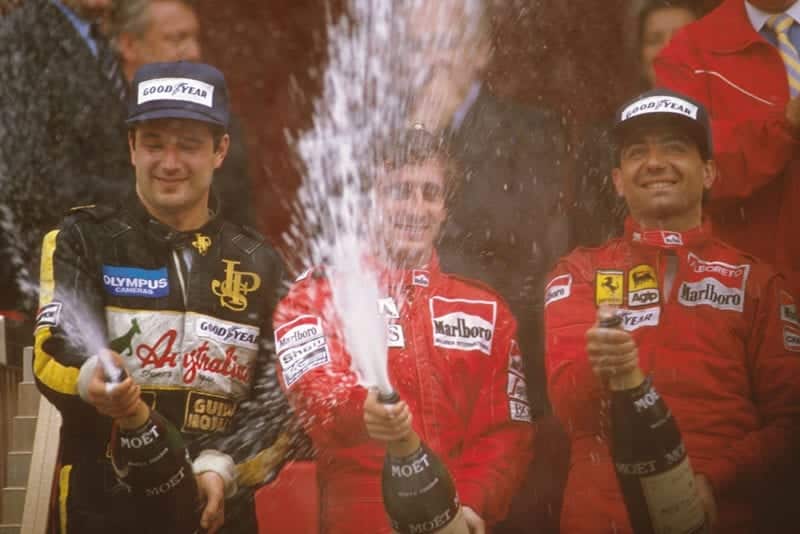
Alain Prost does his grand prix duty, next de Angelis (left) and Alboreto (right)
Motorsport Images
